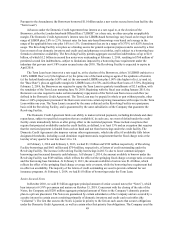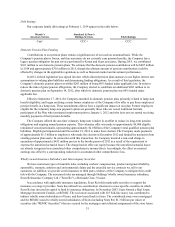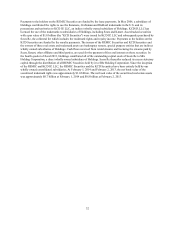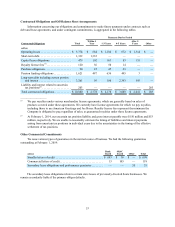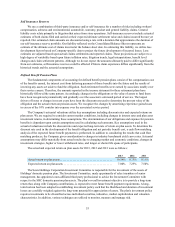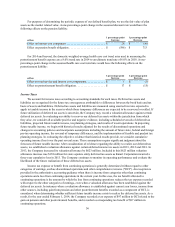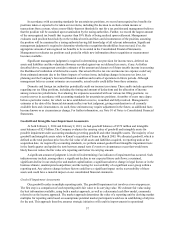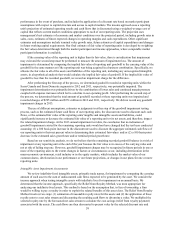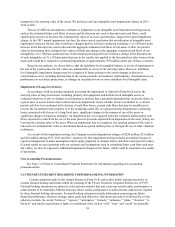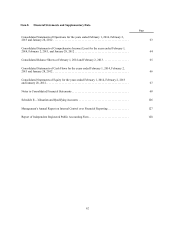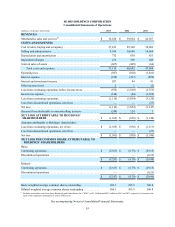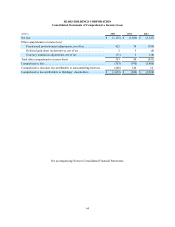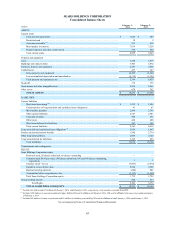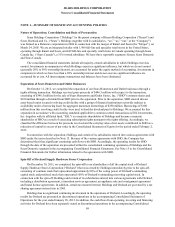Sears 2013 Annual Report Download - page 59
Download and view the complete annual report
Please find page 59 of the 2013 Sears annual report below. You can navigate through the pages in the report by either clicking on the pages listed below, or by using the keyword search tool below to find specific information within the annual report.59
compared to the carrying value of the assets. We did not record any intangible asset impairment charges in 2013,
2012 or 2011.
The use of different assumptions, estimates or judgments in our intangible asset impairment testing process,
such as the estimated future cash flows of assets and the discount rate used to discount such cash flows, could
significantly increase or decrease the estimated fair value of an asset, and therefore, impact the related impairment
charge. At the 2013 annual impairment test date, the above-noted conclusion that no indication of intangible asset
impairment existed at the test date would have changed had the test been conducted assuming: (1) a 100 basis point
increase in the discount rate used to discount the aggregate estimated cash flows of our assets to their net present
value in determining their estimated fair values (without any change in the aggregate estimated cash flows of our
intangibles), (2) a 100 basis point decrease in the terminal period growth rate without a change in the discount rate
of each intangible, or (3) a 10 basis point decrease in the royalty rate applied to the forecasted net sales stream of our
assets and would have resulted in a potential impairment of approximately $70 million under any of those scenarios.
Based on our analysis, we do not believe that the indefinite-lived intangible balance is at risk of impairment at
the end of the year because the fair values are substantially in excess of the carrying values. However, indefinite-
lived intangible impairment charges may be recognized in future periods to the extent changes in factors or
circumstances occur, including deterioration in the macroeconomic environment, retail industry, deterioration in our
performance or our future projections, or changes in our plans for one or more indefinite-lived intangible asset.
Impairment of Long-Lived Assets
In accordance with accounting standards governing the impairment or disposal of long-lived assets, the
carrying value of long-lived assets, including property and equipment and definite-lived intangible assets, is
evaluated whenever events or changes in circumstances indicate that a potential impairment has occurred relative to
a given asset or assets. Factors that could result in an impairment review include, but are not limited to, a current
period cash flow loss combined with a history of cash flow losses, current cash flows that may be insufficient to
recover the investment in the property over the remaining useful life, or a projection that demonstrates continuing
losses associated with the use of a long-lived asset, significant changes in the manner of use of the assets or
significant changes in business strategies. An impairment loss is recognized when the estimated undiscounted cash
flows expected to result from the use of the asset plus net proceeds expected from disposition of the asset (if any) are
less than the carrying value of the asset. When an impairment loss is recognized, the carrying amount of the asset is
reduced to its estimated fair value as determined based on quoted market prices or through the use of other valuation
techniques.
As a result of this impairment testing, the Company recorded impairment charges of $220 million, $35 million
and $16 million during 2013, 2012 and 2011, respectively. Our impairment testing includes uncertainty because it
requires management to make assumptions and to apply judgment to estimate future cash flows and asset fair values.
If actual results are not consistent with our estimates and assumptions used in estimating future cash flows and asset
fair values, we may be exposed to additional impairment charges in the future, which could be material to our results
of operations.
New Accounting Pronouncements
See Note 1 of Notes to Consolidated Financial Statements for information regarding new accounting
pronouncements.
CAUTIONARY STATEMENT REGARDING FORWARD-LOOKING INFORMATION
Certain statements made in this Annual Report on Form 10-K and in other public announcements by us
contain forward-looking statements within the meaning of the Private Securities Litigation Reform Act of 1995.
Forward-looking statements are subject to risks and uncertainties that may cause our actual results, performance or
achievements to be materially different from any future results, performance or achievements expressed or implied
by these forward-looking statements. Forward-looking statements include information concerning our future
financial performance, business strategy, plans, goals and objectives. Statements preceded or followed by, or that
otherwise include, the words “believes,” “expects,” “anticipates,” “intends,” “estimates,” “plans,” “forecast,” “is
likely to” and similar expressions or future or conditional verbs such as “will,” “may” and “could” are generally


